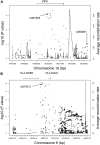Genome-wide association study identifies a novel susceptibility locus at 6p21.3 among familial CLL
- PMID: 21131588
- PMCID: PMC3056639
- DOI: 10.1182/blood-2010-09-308205
Genome-wide association study identifies a novel susceptibility locus at 6p21.3 among familial CLL
Abstract
Prior genome-wide association (GWA) studies have identified 10 susceptibility loci for risk of chronic lymphocytic leukemia (CLL). To identify additional loci, we performed a GWA study in 407 CLL cases (of which 102 had a family history of CLL) and 296 controls. Moreover, given the strong familial risk of CLL, we further subset our GWA analysis to the CLL cases with a family history of CLL to identify loci specific to these familial CLL cases. Our top hits from these analyses were evaluated in an additional sample of 252 familial CLL cases and 965 controls. Using all available data, we identified and confirmed an independent association of 4 single-nucleotide polymorphisms (SNPs) that met genome-wide statistical significance within the IRF8 (interferon regulatory factor 8) gene (combined P values ≤ 3.37 × 10(-8)), located in the previously identified 16q24.1 locus. Subsetting to familial CLL cases, we identified and confirmed a new locus on chromosome 6p21.3 (combined P value = 6.92 × 10(-9)). This novel region harbors the HLA-DQA1 and HLA-DRB5 genes. Finally, we evaluated the 10 previously reported SNPs in the overall sample and replicated 8 of them. Our findings support the hypothesis that familial CLL cases have additional genetic variants not seen in sporadic CLL. Additional loci among familial CLL cases may be identified through larger studies.
Figures

References
-
- Di Bernardo MC, Crowther-Swanepoel D, Broderick P, et al. A genome-wide association study identifies six susceptibility loci for chronic lymphocytic leukemia. Nat Genet. 2008;40(10):1204–1210. - PubMed
Publication types
MeSH terms
Substances
Grants and funding
LinkOut - more resources
Full Text Sources
Medical
Research Materials
Miscellaneous

